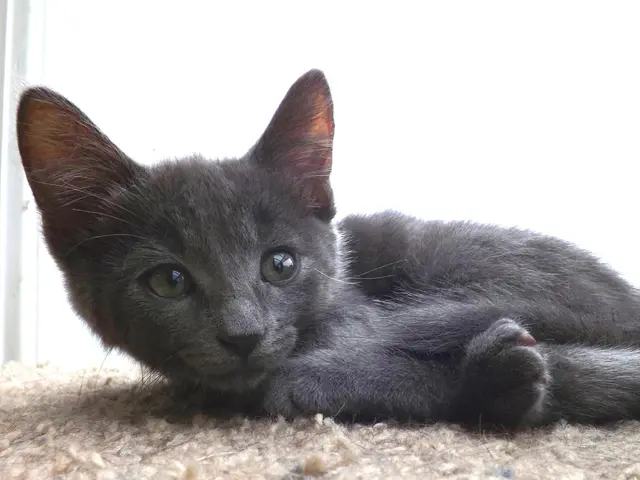Tips for helping your pet shed extra pounds:
Are you worried your four-legged buddy is carrying a bit too many pounds? No sweat! Helping your furry friend slim down is easier than you might think, and there's nothing to stress about. Over 50% of our canine pals are tipping the scales in the wrong direction, and all of that extra pudge is connected to a bunch of health woes. Here's what you can do to get your pooch back in shape:
32 Tips for Helping Your Dog Shed Some Pounds
1. Is Your Dog Overweight?
Before you embark on a weight loss journey for your pup, it's important to confirm they indeed need to shed a few pounds. To determine if your dog is at a healthy weight, you'll want to slide your hand along their sides. If you can feel their ribs, but not see them, you're golden! If not, it's time to take action.
2. Pay Attention to Feeding
It's simple: we tend to give our pups too much grub! Portion control is essential when it comes to managing your dog's weight. Factors like breed, size, age, and activity level will play a role in determining the best diet for your fur friend. Don't rely on the back of kibble packets or food tins for feeding instructions; consult your vet for a personalized calorie count.
3. Portion Control 101
Reducing your dog's meal size is necessary when it comes to weight loss. Instead of cutting back drastically, focus on reducing the portions by 10% each day. This will give your pup time to adjust to their new diet.
4. Change Up Their Diet
Your dog may have been eating the same old chow for years. It's time to switch things up! A ton of commercial dog food dishes are packed with fillers and additives that are bad for your pup's waistline. Opt for cleaner food choices with a short, nutrient-dense ingredient list.
5. Treat Time
Do you spoil your pup with those tasty dog treats? Remember, treats are calorie-dense and can add up quickly, especially if they're given frequently. Treats should make up no more than 10% of your dog's daily calorie intake. Consider using fruit or veggies as low-calorie alternatives for rewards.
6. Weigh Your Dog Frequently
Just like we weigh ourselves to track our progress, weighing your pooch regularly can help ensure they're losing weight at a steady pace. Record the weight in a diary to keep track of their journey.
7. Check for Medical Conditions
If your dog is putting on weight for no reason, it might be due to an underlying health issue. A quick visit to the vet can help rule out any potential problems.
8. Reward in Other Ways
Food isn't the only way to show your pup some love! Many dogs are crazy about praise, cuddles, or even a good old game of fetch. Find reward methods that work for your pooch.
9. Get the Whole Family Involved
Weight loss success relies on everyone in the house being on the same page. If someone is sneaking extra snacks to your pup, it will sabotage your weight loss efforts.
10. Hit the Trails
Regular exercise is essential for weight loss. A walk is an easy and enjoyable way to help your dog burn calories, keep their heart healthy, and stay mentally stimulated.
11. Active Pups Need More Exercise
Some breeds require more exercise than others. Ensure you're giving your pup enough activity each day. High-energy breeds like the Australian Shepherd may need longer, more frequent walks to stay fit.
12. Play More
Life can be busy, but taking 15 minutes out of your day to play with your pup can make a significant impact on their weight loss journey. Play can help burn extra calories and prevent weight gain.
13. Multiple Smaller Meals
Instead of sticking to two larger meals, try feeding your dog several small meals throughout the day. Smaller, more frequent meals can help keep your pooch feeling full while also aiding digestion.
14. Set Meal Times
Dogs thrive on routine. Feeding your pup at set times throughout the day can help regulate their metabolism and digestive system.
15. Limit Table Scraps
It's hard to resist those adorable puppy eyes, but resist you must. Table scraps can add up quickly, especially if they're packed with butter or other calorie-rich ingredients.
16. Keep a Food Diary
Writing down everything your dog eats and the portion sizes will help you keep track of their weight loss progress.
17. Supplements
While supplements won't directly help with weight loss, they may make the weight loss journey a bit smoother. Supplements can help with joint pain, making exercise more comfortable.
18. Limit Carbs
Many commercial dog foods are carb-heavy, which can contribute to weight gain. Opt for low-carb, whole foods to keep your pup satisfied and aiding weight loss.
19. Treats with a Twist
Skip the pre-packaged treats in favor of fruit and veggies. Carrots, broccoli, cucumber, blueberries, apples, and bananas can make healthy treats. Be mindful of the sugar content in fruit.
20. Recognize Begging vs. Hunger
Begging often isn't an indication of hunger, especially if your dog is already well-fed. Practice ignoring the begging, and your pup will quickly learn to stop seeking food this way.
21. Gradual Change
Transition your dog's food and meal sizes gradually to avoid any digestive upset. If you're changing dog food or feeding methods, introduce the new stuff slowly.
22. Give Swimming a Try
Swimming is a great low-impact exercise that's easy on joints, making it a good option for senior dogs or those with mobility issues. Swimming sessions can help burn calories, strengthen muscles, and improve cardiovascular health.
23. Consider Your Dog's Age
Older dogs are more susceptible to weight gain, as excessive weight can lead to a host of health problems. Proper portion control is essential to avoid weight gain in senior dogs.
24. Food Diary Athome
Keep a detailed food diary to track your dog's daily caloric intake and make it easier to adjust their diet as needed.
25. Automatic Feeder
Automatic feeders can help make controlling portions and feeding times a breeze. Consider investing in one if you're struggling to feed your furry friend consistently.
26. Hiking Time
Hiking with your dog can make for a fun exercise experience for both you and your pup. It's a great way to burn calories, improve cardiovascular health, and strengthen muscles.
27. Crate Time
If you find it hard to resist feeding your dog table scraps, consider keeping them in a crate while you dine. This will prevent them from begging or stealing food from the table.
28. Offer Water
Dogs sometimes confuse thirst for hunger. Offer fresh water to your pooch instead of food if they seem to beg for it, as a big drink of water can help them feel full.
29. Breed-Specific Needs
Some breeds are more prone to weight gain than others. Beagles, pugs, golden retrievers, Labradors, and bulldogs, among others, are at higher risk of obesity. Be mindful of your dog's breed and adjust their diet and exercise accordingly.
30. Choose a Puzzle Feeder
Puzzle feeders can help keep your dog mentally stimulated while they lose weight. Puzzle feeders work by making your dog work for their kibble, slowing down their mealtime and helping them feel full longer.
31. Consult Your Vet
Before making any major changes to your dog's diet or exercise routine, consult your vet for professional advice. Your vet can help create a personalized weight loss plan tailored to your dog's unique needs.
32. Slow and Steady Wins the Race
Weight loss and maintenance is a marathon, not a sprint. Consistency is key, so stay persistent and trust that with the right diet, exercise, and mindset, your pup will shed those excess pounds and reach their ideal weight.
If your dog is losing weight unexpectedly, consult your vet to determine the cause. Learn more about obesity in dogs and how to help prevent weight gain.
- If your cat seems to be carrying a few extra pounds, it's important to confirm that they need to shed some weight. slid your hand along their sides. If you can feel their ribs, but not see them, you're on the right track! If not, it's time to take action.
- Just like proper nutrition is crucial for our own health, it's equally important for our pets. To determine the best diet for your feline friend, consult with your vet about the proper food choices based on their breed, size, age, and activity level.
- Treating your cat with toys can be a great way to engage them in play and help burn calories. opt for interactive toys that encourage prolonged play sessions, as these can keep your cat mentally stimulated while also aiding weight loss.
- Paying attention to training methods can help improve your cat's behavior and promote a healthier lifestyle. positive reinforcement techniques, such as rewards with treats or praise, can help your cat learn appropriate behaviors.
- Cats, like dogs, can also develop behavioral issues that may contribute to weight gain. Consult with a veterinary behaviorist if you notice any abnormal behavior that may be affecting your cat's weight.
- Providing a clean and comfortable living environment is essential for your cat's overall health and well-being. Ensure your home-and-garden is cat-friendly by providing plenty of safe spaces for them to rest and play.
- Regular veterinary checkups are essential for monitoring your cat's health and addressing any potential medical issues that may be contributing to weight gain. consult your vet to rule out any underlying health problems.
- Cats, especially senior cats, are more susceptible to weight gain and the associated health risks. proper portion control and a balanced diet are essential for maintaining a healthy weight in older cats.
- Keeping a food diary for your cat can help you track their daily caloric intake and make it easier to adjust their diet as needed.
- Understanding your cat's specific needs based on their breed, age, and lifestyle is crucial for creating a personalized weight management plan. consult with a vet specializing in feline care for tailored advice on achieving and maintaining a healthy weight for your pet.
- Consult a professional trainer or a behavior specialist if you need help implementing positive reinforcement training methods or addressing any behavioral issues contributing to your cat's weight gain.
- Regular exercise, such as playtime with toys or interactive games, can help your cat maintain a healthy weight and overall well-being.
- It's essential to provide your cat with plenty of opportunities for exercise and activity, especially if they are indoor-only or have limited opportunity for outdoor play. engage your cat in interactive play sessions multiple times a day to help burn extra calories and prevent weight gain.
- Offering a variety of healthy food options, such as high-quality cat food, low-calorie treats, and fresh foods like meat, fish, and vegetables, can help keep your cat satisfied while keeping their weight in check.
- Overindulging your cat with excessive treats can lead to weight gain. instead, offer low-calorie treats as rewards during training sessions or as special treats on occasion.
- Regular veterinary checkups can help you stay informed about your cat's weight and keep their weight at a healthy level.
- Monitoring your cat's weight regularly and adjusting their diet and exercise routine as needed is essential for maintaining a healthy weight.
- Keep a close eye on your cat's behavior and appetite, as a sudden change in either could indicate an underlying health issue that may be contributing to weight gain. consult your vet if you notice any unusual behavior or changes in your cat's appetite.
- Minor lifestyle changes, such as switching to a lower-calorie food or implementing a more active lifestyle, can make a significant impact on your cat's weight management.
- Weight loss isn't always a straightforward process, but with proper care, patience, and a bit of effort, you can help your feline friend achieve and maintain a healthy weight. Don't forget to consult your vet for personalized advice and guidance throughout the process.







